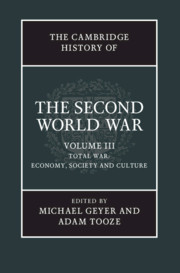
- Cited by 8
-
Cited byCrossref Citations
This Book has been cited by the following publications. This list is generated based on data provided by Crossref.
2015. Other Books Received. The American Historical Review, Vol. 120, Issue. 4, p. 1592.
Alieva, Liudmila V. Antonova, Lidia V. and Khrishkevich, Tatiana G. 2019. Contemporary historiography on the phenomenon of the social cohesion in the period of the Second World War. Journal of the Belarusian State University. History, p. 7.
Fennell, Jonathan 2019. Fighting the People's War.
Bottelier, Th. W. 2020. ‘Not on a purely nationalistic basis’: the internationalism of Allied coalition warfare in the Second World War. European Review of History: Revue européenne d'histoire, Vol. 27, Issue. 1-2, p. 152.
Winter, Jay 2022. The Cultural History of War in the Twentieth Century and After.
Bottelier, Th. W. 2023. The maritime perspective: Placing the oceans in the study of the Second World War. Journal of Strategic Studies, Vol. 46, Issue. 2, p. 451.
Bret, Patrice 2024. Global History of Techniques. Vol. 9, Issue. , p. 581.
Edgerton, David 2024. The United Kingdom's disappearing wartime imports 1939–45: A statistical, ideological, and historiographical accounting. The Economic History Review, Vol. 77, Issue. 1, p. 119.
- Publisher:
- Cambridge University Press
- Online publication date:
- June 2015
- Print publication year:
- 2015
- Online ISBN:
- 9781139626859




